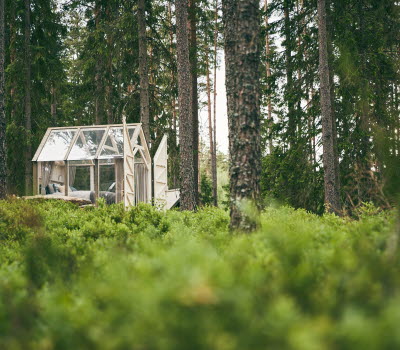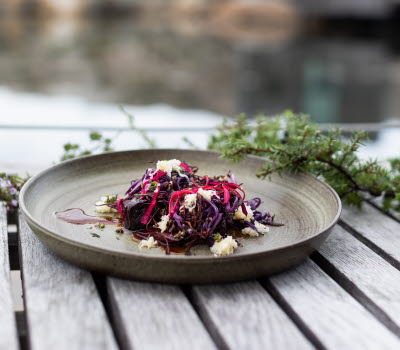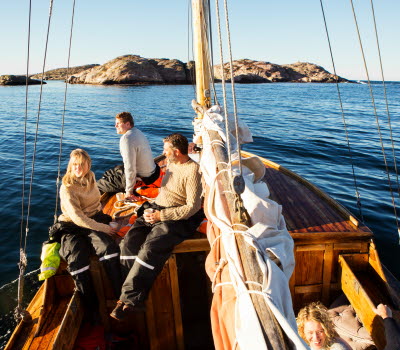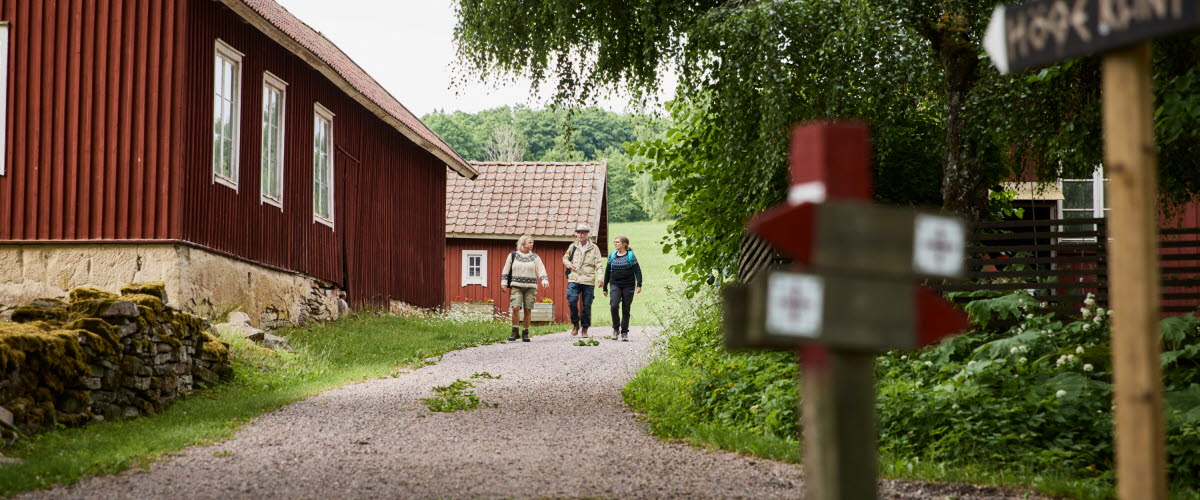The Pilgrim Path Hjo-Kungslena – Hike from lakes to hills
The Pilgrim Path between Hjo and Kungslena is an idyllic trail taking you from wooden town Hjo and over scenic Hökensås to the medieval village of Kungslena. Along the way you can explore lots of historic sights, lovely beaches and lookout points.
The 44 kilometre long Pilgrim Path Hjo-Kungslena is perfect for anyone wanting a relatively easy hike through varying scenery. You can walk it at your own pace and rest your legs whenever it suits you.
It might not be one of the best known hiking trails in West Sweden but that doesn't mean that it doesn’t provide exciting experiences. Quite the opposite! On your walk you can enjoy beautiful sandy beaches, an internationally award winning cheesery, sweeping views and old settlements with a fascinating history. You can read more about some of the best known sights below.
Photographer: Jonas Ingman
10 places to see along the Pilgrim Path Hjo-Kungslena
1. The picturesque wooden town of Hjo
Hjo is a famous wooden town on the shores of Lake Vättern, where you’ll find cobbled streets, turn of the century villas, delicatessens and a leafy park overlooking the lake.
The Pilgrim Path starts by the wharf, and what’s the best way to start your walk? With an ice cream of course! There are two popular ice cream parlours in the harbour area, Moster Elins Glass and Gula Paviljongen. You can also watch SS Trafik here, one of the best preserved steam boats in the country.
From the wharf cross the bridge over the Hjo river which leads up to the church, the town square and finally the Strandpromenad shoreline path, which locals call the “Hjovieran”. You’ll find Sweden’s longest lit bench here, and plenty of spots for a refreshing dip.
Handy hint! If you want to stay over we can recommend the STF Vandrarhem Villa Eira in the town park, Hotell Bellevue by the harbour and Röda Stallet B&B which you’ll pass just south of Hjo.
Hjo
2. The churches – the pilgrim’s second homes
Most people doing pilgrimages these days are just doing it to get out in nature, discover new places and exercise. But the concept of pilgrimages also has a long history with a spiritual connection, and a sign of that is all the churches you’ll pass. Along the Pilgrim Path Hjo-Kungslena there are several churches where you can shelter for a while, rest your legs or light a candle and reflect.
Hjo church is in the centre of the town square, and as you walk south from Hjo you’ll pass Norra Fågelås church, with its well preserved clock tower from 1363. Klämmesbo Chapel, Fröjered Church and Hömb Church are also worth a stop. And of course Kungslena Church, which with its three towers is a spectacular sight.
Photographer: Jonas Ingman
3. Göransnäset swimming area
Just south of Norra Fågelås Church there’s a pretty swimming area to stop at, Göransnäset, where you can dip your toes in Lake Vättern’s clear waters.
You’ll also find a circular nature trail around Göransnäset. The approximately four kilometre long loop follows the shoreline through leafy woodland most of the way, and takes you to Almnäs Bruk and back.
Göransnäset swimming area
4. Almnäs Bruk
Almnäs Bruk is a historic farm with medieval roots, in a lovely setting overlooking Lake Vättern. More recently, cheese making has put the farm on the map. There have been several cheeseries here over the years, going all the way back to the 1830s.
These days the cheese is made in the old snaps distillery, and all the milk comes from cows grazing in the fields around Almnäs. The farm is completely organic.
Their Almnäs Tegel cheese has won several international awards, and Wrångebäck was the first cheese in Scandinavia to receive Protected Designation of Origin. It’s also Sweden’s oldest registered cheese trademark. You should definitely buy some cheese from the farm shop to enjoy as you continue your hike.
Almnäs bruk
5. The view from Böjan
When you’ve passed Korsgården and route 195 there’s the option to do a short detour north, which we highly recommend because you’ll get to the Böjan outlook point, with fantastic views of Lake Vättern. If you’re lucky with the weather you can see fully three quarters of the lake, from the north tip of Omberg to Gränna in the south.
There’s a bench where you can rest your legs and an information board about the area. The detour is 700 metres one way and signposted.
Photographer: Jonas Ingman
6. Hökensås and Hållsdammarna
A lot of the route is over open farmland, but for the forest lovers among us the stretch over Hökensås is a high point. You’ll be met by fir and pine forests with bilberry bushes as far as the eye can see. Hökensås is a mecca for bilberry pickers.
Up on Hökensås there’s a collection of small lakes like a string of pearls, called the Hållsdammarna. The perfect place to stop for a picnic or fika.
Don’t miss the chance to stay overnight in a unique ‘tiny house’, right in the middle of the forest a couple of kilometres from the path. Read more and book at Inforest.
Top tip! On the way up Hökensås you can do a round walk that takes you past Hökensås Golf Club where you can eat a tasty lunch. This alternative loop is around five kilometres long and you’ll come out on the Pilgrim Path again up by the Hållsdammarna.
Hållsdammarna
Inforest
7. Fröjered swimming area by the river Tidan
One of the small towns you’ll come to along the Pilgrim Path is Fröjered, in the municipality of Tidaholm. The river Tidan runs through the town, a favourite haunt of canoeists. There’s a lovely sandy beach and a popular swimming jetty. During summer a kiosk and mini-golf are open just next to the swimming area.
Photographer: Miranda Bergsten
8. Hömbs church village
An avenue of towering trees leads you up to the idyllic linear village of Hömb. Along both sides of the village street red wooden houses line up, some with thatched roofs. The cottages date back to the 17th century and were originally built around Hömbs church. They were moved to their present location at the beginning of the 1800s.
In the past the cottages were used as accommodation for people working in Kavlås Castle, which you’ll walk past just after Hömb.
Photographer: Jonas Ingman
9. Kungslena
The end destination for this stretch of the Pilgrim Path is Kungslena, or just Lena as the parish was originally known, probably from the Old Norse word “len”, which means hillside.
After Kungslena’s old church was burnt down during a battle in 1208 the new one was built, which with its three towers is unique of its kind. The central of the three towers is said to symbolise the statesman and regent Birger Jarl. Legend has is that in 1258 Jarl attended High Mass in the church with King Håkon of Norway and his son Valdemar, who was then too young to rule Sweden, and the three towers were built after that.
Have a look inside the church to admire the large and detailed 18th century paintings. The 12th century sandstone baptismal font from the old church has also been kept.
Photographer: Jonas Ingman
10. Höge Klint lookout point
If you have any strength left in your legs when you get to Kungslena we highly recommend an extra push up to the Höge Klint lookout point on Varvsberget. Along the path you’ll see remains of an ancient castle and on the summit, 315 metres above sea level, there’s a wonderful view of the whole area. It’s about a one kilometre walk to the lookout point and you’ll find a shelter with a grill area up there.
Varvsberget is part of the Platåbergens Geopark and has had several aliases over the years, including Kungslenaberget, Fårdalsberget and Granberget.
Höge Klint
Facts about the trail
Length: The trail is 44 kilometres
Timing: Around 15 hours (suitable for 2-3 days walking)
Difficulty: Easy. Easy walking mostly on gravel roads and paths.
Terrain: Asphalt, gravel roads, farmland and forest paths.
Waymarking: Classic pilgrimage waymarking in the form of a red St Olof’s sign.
Clothes and equipment: Good walking shoes, rucksack with food, water bottle and clothes suitable for the weather. If walking longer than one day you’ll need a change of clothes and accommodation plans.
Insta-moments: All the pretty wooden houses in Hjo, and the view of Lake Vättern.














